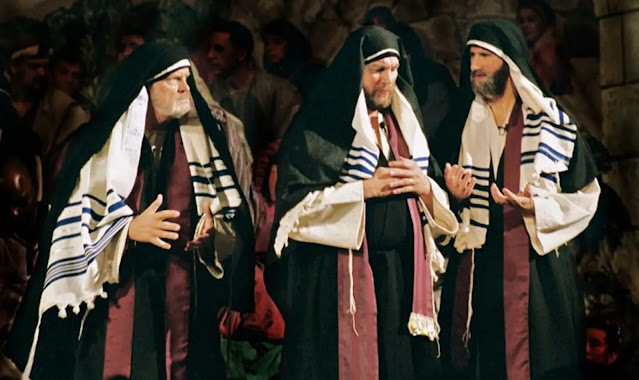GEMS FROM JEREMIAH (30) Jeremiah & Jesus, part II: covenant & kingdom
“[Jesus] also said, “With what can we compare the kingdom of God, or what parable will we use for it? It is like a mustard seed, which, when sown upon the ground, is the smallest of all the seeds on earth; yet when it is sown it grows up and becomes the greatest of all shrubs, and puts forth large branches, so that the birds of the air can make nests in its shade.” (Gospel of Mark 4.30-32)
What were
Jeremiah and Jesus trying to accomplish?
Both prophets seemed to have dedicated their lives to a fool’s errand. In the case of Jeremiah, God told him at the
moment of his calling that his audience would resist his message (Jer. 1.17-19)
and as we read the book of Jeremiah, it often feels like the destruction of
Judah is a foregone conclusion. As for
Jesus, he quoted the prophet Isaiah to describe his contemporaries’ inability
to understand his teaching (Mk. 4.11-12; cf. Is. 6.9-10). Both Jeremiah and Jesus called their
contemporaries to “repent”, i.e., to change their ways, but with very mixed
results. In both cases, the worse predictions
of the two prophets came true.
Jeremiah
spent his life pleading, cajoling and threatening Jerusalem to return to
faithfulness to the covenant with Yahweh as stipulated in the book of Deuteronomy. Jeremiah insisted that covenant faithfulness
was the way to “life” (cf. Dt. 30.15-20; Jer. 21.8-10). However, the Judahites continued to put their
trust either in pagan deities (cf. Jer. 7.16-18) or in political alliances with
pagan nations (cf. Is. 36.6). As Judah’s
very survival was threatened, the people of Yahweh looked everywhere but to
their God for salvation, and instead, met with disaster.
At the time
of Jesus, the issue was no longer idolatry, but rather defining what
faithfulness to the covenant looked like.
Added to the variety of expressions of covenant-faithfulness that were
on offer was the added hope for the advent of the “kingdom of Yahweh”, the
reign of the true King of the Universe/Israel which would displace the pagan
empires that had subjugated the people of God for centuries (cf. Dn.
2.44-45). The Scriptures were replete
with promises of this moment of liberation that would make the Golden Age of
David/Solomon seem insignificant in comparison.
Well, centuries had come and gone since these promises had been
made. Life had gone on – the harsh reality of trying to eke an existence
out of the soil and the flocks, all the while being bled dry by taxes and
subjugated to the daily humiliations of being a conquered people in an
enemy-occupied land. Hopes had been raised and dashed, time and
time again. Several groups formed in
the centuries before the birth of Jesus, each one having its own view of the
kingdom and what one should do in the present to hasten the kingdom’s/the king’s
arrival.
Many undertook
an intense study of the Scriptures, looking frantically for clues as to when
the great moment would arrive (usually trying to figure out when Daniel’s 70
weeks would come to an end: Dn. 9.24-27.
The more things change…) and trying to teach others how they should be
living in the meantime (= the Pharisees). This was a “kingdom by torah-observance”
movement. Others had gotten tired of
waiting and decided to “storm the Capitol” in the hope that God would notice
and “get with their program”, one of revolt against the enemies of Yahweh’s
people (= the Zealots, brigands).
This was a “kingdom by violence” movement. Many priests who had become fed up with the
corruption of the Sadducean hierarchy in the Jerusalem Temple fled to
Qumran by the Dead Sea to await the Day of the Lord with the Essene
community. This was a “kingdom by piety”
movement. Pharisees, Sadducees, Zealots and Essenes – the first-century Jewish historian
Josephus described these groups to the Romans as constituting the “Four philosophies”
of Judaism. The program of all of
these “kingdom” movements was to mark themselves out in the present time as
being the true, faithful people of God over against pagans and “sinful”
Jews. When God returned to establish his
kingdom, he would “justify” and vindicate those who had demonstrated their
loyalty to him as being the true people of God.
They would enter the Age to Come as the Righteous (i.e., the “justified
ones”).
While Jeremiah called the people to turn
from their idolatry, and failing that, to throw themselves on the mercy of the
Babylonians (=Yahweh?!), Jesus called his contemporaries to a radical imitation
of Yahweh, who makes the sun shine on the bad and good alike (cf. Mt. 5.38-48). Jesus calls his generation to the love of
enemy, i.e., the Roman occupiers and the Jewish collaborators that collected
their taxes. Jesus subverted all notions
of self-preserving nationalism that had attached themselves to the hope for the
kingdom of God among many of his contemporaries. Jesus offered his own interpretation of the reign
of God – his was a “kingdom by suffering service” movement (cf. Mk. 8.27-38;
10.32-45). Indeed, as far as Jesus was
concerned, the way to honour the covenant was to serve “the nations” by being “the
salt of the earth and the light of the world” (Mt. 5.13-16). This would inevitably lead to suffering, but
also future vindication (Mt. 5.9-12). Of
course, then as now, the upside-down kingdom of Jesus remains invisible to
those who are blinded by fear and pride…
“for those outside,
everything comes in parables; in order that
‘they may indeed look, but
not perceive,
and may indeed listen, but not understand;
so that they may not turn again and be forgiven.’” (Mk. 4.11-12)
“Then he began to teach
them that the Son of Man must undergo great suffering, and be rejected by the
elders, the chief priests, and the scribes, and be killed, and after three days
rise again.” (Mk. 8.31)




Comments
Post a Comment